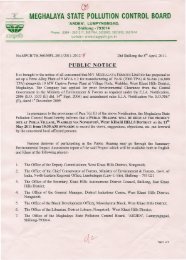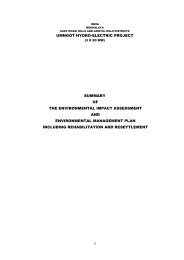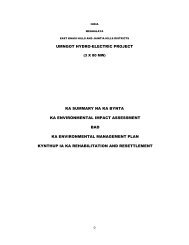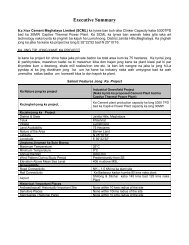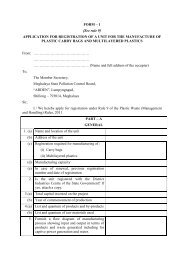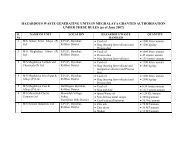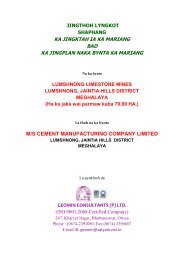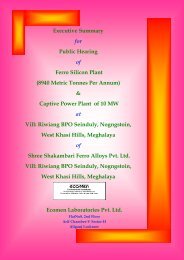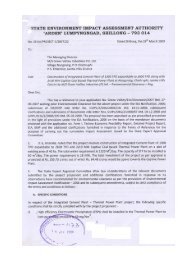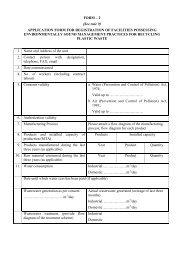chapter - 1 introduction - Meghalaya State Pollution Control Board
chapter - 1 introduction - Meghalaya State Pollution Control Board
chapter - 1 introduction - Meghalaya State Pollution Control Board
Create successful ePaper yourself
Turn your PDF publications into a flip-book with our unique Google optimized e-Paper software.
Hills Cement Co. Limited.<br />
particles and encourages growth of an active culture of aerobic<br />
organisms. Main features of aerobic treatment are to clarify effluent by<br />
absorbing majority of colloidal and suspended solids on the surface of<br />
sludge particles and oxidize organic matter.<br />
Over flow from aeration tank shall flow by gravity to secondary clarifier<br />
(Tube settler). A part of the sludge from secondary clarifier is recirculated<br />
to aeration tank to maintain desired quantity of mixed liquor<br />
suspended solids (MLSS) and excess sludge is sent to sludge drying<br />
beds. The dried sludge is composted and used as manure for green<br />
belt. The clarified and treated wastewater from secondary clarifier is<br />
collected into a storage tank and passed through pressure sand filter<br />
and used for green belt. The treated sewage shall have the following<br />
characteristics.<br />
pH : 6.5 to 8.5<br />
Total Suspended Solids : < 50 mg/L<br />
Biochemical Oxygen Demand : < 30 mg/L<br />
COD : < 100 mg/l<br />
Oil & Grease : < 10 mg/L<br />
Solid Waste Disposal<br />
Solid wastes from Thermal Power Plants generally consist of fly ash<br />
and solid waste from faecal sewage. The following measures will be<br />
taken to reduce/re-use the solid wastes:<br />
• Bottom ash, almost in dry form will be sieved for re-cycling as bed<br />
material in the AFBC Boiler.<br />
• Fly ash, collected in various hoppers of he dust collection Systems<br />
provided in the path of the flue gas, will be pneumatically transported<br />
to the silos from where the same will be taken out to ash dump area by<br />
totally enclosed dumpers.<br />
• Normally, the dry ash will be utilized for secondary use, land filling,<br />
road construction, cement making, etc.<br />
• Green belt around ash disposal area will be developed.<br />
The municipal solid waste generated from the plant and the colony<br />
will be segregated and separated as combustible and noncombustibles<br />
wastes. The combustible wastes will be used as fuel<br />
in the kiln. This will solve the problem of solid waste disposal and<br />
will also reduce the fuel requirement for the kiln. The kiln will act as<br />
an incinerator in this case. The non-combustible wastes will be land<br />
<strong>Pollution</strong> <strong>Control</strong> Consultants (India) Pvt. Ltd. 102



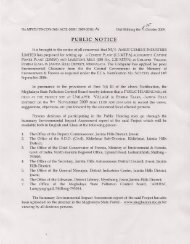
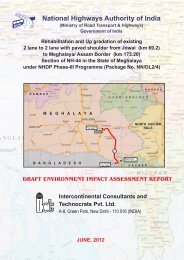

![[FORM I] - Meghalaya State Pollution Control Board](https://img.yumpu.com/49771786/1/190x245/form-i-meghalaya-state-pollution-control-board.jpg?quality=85)

